
A Technology in Education Philosophy...
Utilizing a variety of topics, technologies, and graphic mediums, I am absolutely passionate about providing the highest quality learning experience that will produce global citizens and leaders prepared to positively shape the future of the US, and the world. In all my classes, student demand/course requests increased greatly in the last decade, and subsequently I have increased class sizes to accommodate the need.--from 50 to 500 to 3000 students. As fate would have it, innovations in communications and internet technologies have also increased dramatically in the last decade as well, making these larger and larger classes not just possible, but practical, productive and propitious as well!
At the risk of offending the luddite lecturers, I do have to espouse what an exciting time it is to be in education as all these fantastic new technologies are now at our disposal to communicate, teach, and excite our students in ways never before imagined. I do want to clarify one point though: we only use technologies to enhance learning and increase communications between the students and the instructor....I never adopt tech just for tech's sake, and have never been interested in utilizing new 'bells and whistles' just to appear savvy or hip or on the cutting edge. Technologies are utilized to increase access and engagement, not to replace the tradition of teaching itself, which I consider a human endeavor of the highest order that will never be replaced by pre-recordings and robots.
In that spirit, we have adopted and adapted a variety of new technologies in virtually all aspects of course design, course management, and interaction that can be roughly categorized by its mission. I use technologies to help connect students with each other and build community; technologies that help connect 3000 students to a single professor in a meaningful way with real dialogue; technologies incorporated into class assignments to make the education interactive and engaging; and even social networking technologies that create camaraderie and special events. Below is an abridged list of some of the specific devices we use in my classes, with a brief description of how we use them, as well as insight into my syllabi, and links to educational-focused technology talks I have given recently.
Page outline
-
Communication Technologies in and out of the Classroom
- Twitter and Facebook
- Twitter Hashtag
- PollEveywhere
- Ustream and Spreecast
- The Plaid Avenger Website
- Video Lectures
- Plaid Avenger Podcasts
- iTunes University
- Turntable.fm
- Social Networked Events
- The "Flipped Syllabus"
- Technologies Used in Assignments
- Sharing Our Educational Experiences with the World
Communication in and out of the Classroom
Online communication tools are used extensively to promote greater student engagement and interactivity within the classroom academic setting, but also in the 24/7 real world as well. Today's students have evolved past utilizing traditional lectures, face-to-face office hours, and even email as primary communication devices. Like it our not, this generation of learners is tied into multiple platforms of instantaneous information exchange, and instead of fighting it, I have chosen to embrace this 'lingua franca' in order to increase interaction between myself and the students, but just as important, between the students themselves. This 1)increases accessibility of the instructor as a resource, 2)provides multiple avenues for information dissemination, but also 3)builds a 'course community' that takes on a life of its own.
 Among the tools used to acheive these goals are Facebook and Twitter, Ustream and Spreecast (videocasting), PollEverywhere (peer voting), The Plaid Avenger blog and iTunes University (permanent online educational pages and info sharing), and even TurnTable, a community music tool. And here is what each of these things is, and what we use them for....
Among the tools used to acheive these goals are Facebook and Twitter, Ustream and Spreecast (videocasting), PollEverywhere (peer voting), The Plaid Avenger blog and iTunes University (permanent online educational pages and info sharing), and even TurnTable, a community music tool. And here is what each of these things is, and what we use them for....
Twitter and Facebook I use both Twitter and Facebook to make announcements and to share interesting news stories, class assignments, and general information. The students in response reply and post many of their own news stories or ask questions to the professor, many of which get answered by fellow students. Many students end up following the news more because of these updates, encouraged even more by the direct interaction with the professor and their classmates.
Twitter Hashtag Increasing communication and discussion both during and after lectures is facilitated through the use of a class Twitter hashtag. This tool is used to organize class tweets, encourage community by following class peer posts, and sharing information about the class, current events, or campus activities that are applicable to the course. It is live-streamed to the screen during class, and followed/managed by a technical assistant who can then feed pertinent questions or comments to the professor during the live lecture, but is also utilized by students as a 24/7 information exchange avenue.
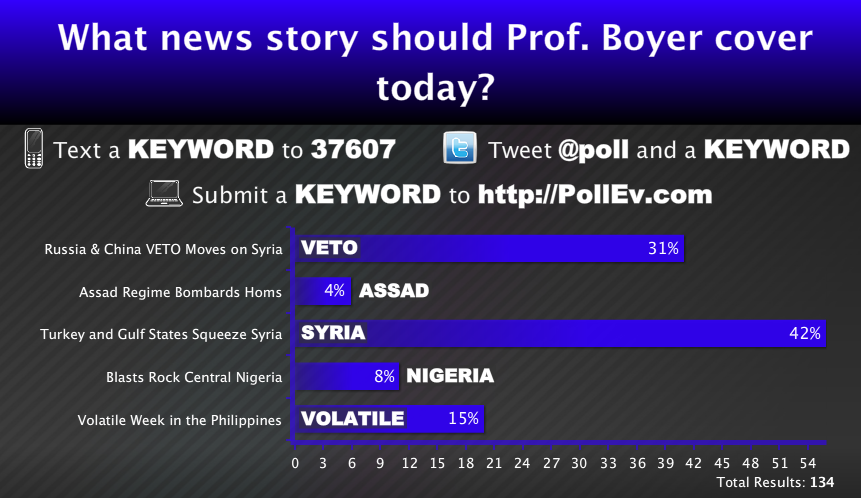 PollEverywhere To increase participation and communication in class, the program, Poll Everywhere, is used for instantaneous text message polling during lecture. Students are asked for input regarding what current news stories or world regions should be discussed in class. Students text, use Twitter, or use the web interface to submit their answer to the instructor who responds by adapting his instruction to student requests and including the requested content in class presentations.
PollEverywhere To increase participation and communication in class, the program, Poll Everywhere, is used for instantaneous text message polling during lecture. Students are asked for input regarding what current news stories or world regions should be discussed in class. Students text, use Twitter, or use the web interface to submit their answer to the instructor who responds by adapting his instruction to student requests and including the requested content in class presentations.
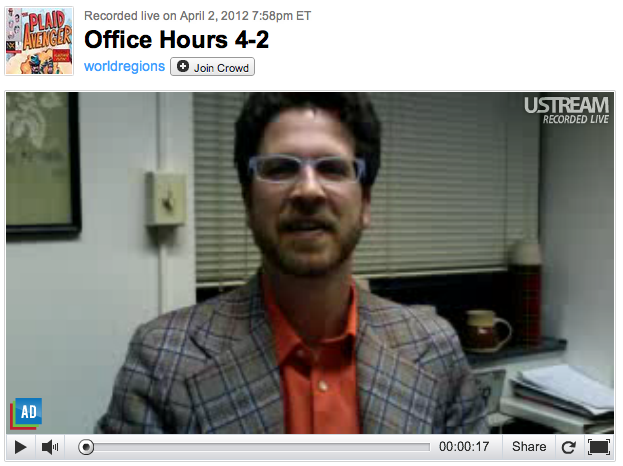 Ustream and Spreecast The office hours entail the instructor launching a live interactive online broadcast (see Ustream.com) that is available to anyone connected to the web – students, alumni, and random visitor. Feedback has been great: between 10 to 15% of the class tune in to watch and participate, even though there is no grade incentive to do so. The online office hours involve students instant messaging (IM) the instructor questions that he then responds to live; simultaneously, the instructor’s technical assistant is monitoring a chat room of hundreds of students, answering course-related questions and forwarding current event questions to the instructor to be answer “on air.” The online office hours provide individualized feedback and instruction in an ultra-large class by leveraging the power of interactive digital technologies. See http://www.ustream.tv/channel/prof.-boyer%27s-office-hours for recorded examples, as all of these interactions are recorded and archived, free of charge!
Ustream and Spreecast The office hours entail the instructor launching a live interactive online broadcast (see Ustream.com) that is available to anyone connected to the web – students, alumni, and random visitor. Feedback has been great: between 10 to 15% of the class tune in to watch and participate, even though there is no grade incentive to do so. The online office hours involve students instant messaging (IM) the instructor questions that he then responds to live; simultaneously, the instructor’s technical assistant is monitoring a chat room of hundreds of students, answering course-related questions and forwarding current event questions to the instructor to be answer “on air.” The online office hours provide individualized feedback and instruction in an ultra-large class by leveraging the power of interactive digital technologies. See http://www.ustream.tv/channel/prof.-boyer%27s-office-hours for recorded examples, as all of these interactions are recorded and archived, free of charge!
In a non-stop effort to discover the newest, best-est programs to serve our class needs, we have starting experimenting with Spreecast, a similar on-line live-hosting site that is very similar to Ustream. However, the added advantages of Spreecast include no advertisements which interrupt the conversation, the ability to stream users video into the conversation (a student can elect to ask their question live via video feed, and they would show up on screen too), and increased functionality and tools to manage the 'crowd' that is tuned in and share resources with them in real time. (http://www.spreecast.com/)
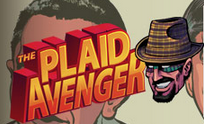 The Plaid Avenger Website
The Plaid Avenger Website
With the wealth of information that is now available on the web, my problem as an instructor has increasingly been how to sift through all the junk to get to the good stuff, and how to gather resources and trusted media outlets that focus the desired content for my courses that I want students to see. To achieve this mission, while also providing additional analysis and a forum for feedback, we created an entirely independent, open-access, all-free website to house course materials and regularly updated current event analysis: www.plaidavenger.com
The site is thematically based on the World Regions textbook (The Plaid Avenger's World), and provides students with a plethora of information, extended content, regular new assessments of current events, opportunities to interact with the instructor and other students, and a centralized repository of all course constructions (e.g., podcasts, office hours). This site is creating an entire interactive educational platform for students to use to gain knowledge from other students and professionals around the globe, but also to share knowledge at the same time through group forums and direct conversations. Also, I am connecting with several professors from different universities across the country who have adopted the Plaid Avenger's World textbook and are interested in developing a "shared classroom experience" via the site as well. This will be explored, developed, and executed in the coming academic year.
Specific components of the Plaid Avenger site that incorporate technologies that increase interaction and provide modern avenues of information dissemination include:
Video Lectures
A continuing project in process, much of the course content is being produced as pre-recorded lectures (with graphics, notes, and quizzes) and provided online at http://www.plaidavenger.com/worldregions/ and at iTunes University. In this format, students can review the lectures multiple times, start and stop them as needed to take notes, and even makes the course material more flexible in that they can watch it at their own pace and customized to their personal schedules. This allows more class time to be spent on analysis, debate, dialog, and special events. Also unique is the fact that all of the videos, resources, and forums are accessible, free, and widely utilized by the general public. I authored the class text, The Plaid Avenger’s World, now used at 20+ other universities, as well as several supplemental editions (Arab Revolution Edition, Western World Edition), and these on-line video lectures are now being utilized by other classrooms using the textbook, but also random high school classes and increasingly the general public who are interested in lifelong learning and real understanding of the world.
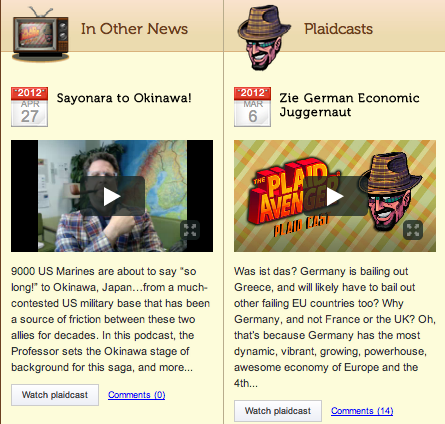 Plaid Avenger Podcasts
Plaid Avenger Podcasts
The Plaid Avenger website's major feature is a continually updated stream of current events assessment that pulls in headlines from around the globe and explains them in more detail than the 30-second sound-byte news that plagues our countries and dooms the masses to ignorance. Basically a continuation of class lectures, these current events video blogs integrate course material and continue class discussion on events that are critical to understanding our changing world. Either 'The Professor' or sometimes 'The Plaid Avenger' himself appear on a brand new video blog on-line 1-2 times weekly to explain and elaborate on current events as they are unfolding. Students from class or anywhere in the country can tune in and get turned on to what is actually happening out in the real world, as the man in plaid makes the connections from the page to the planet. http://www.plaidavenger.com/plaidcasts/all/
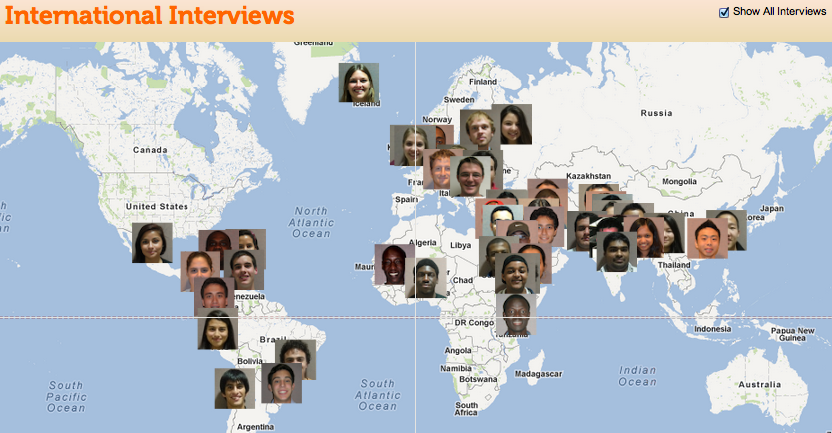 The International Interview is an audio interview show I just created in 2011 that is already generating a lot of excitement from everyone who sees it or hears about the concept. It focuses on interviewing international students and faculty here at the university in order to discover and share cultural insights from the rest of the world, with the conversation having no strict format or mission. It is simply a sharing of insights between countries and cultures...you know, the way real people talk to each other and learn from one another. 75 interviews conducted already, and once a critical mass of interviews is built up will be devising a student research project based on the content of the project. You can see the interviews posted thus far at:
The International Interview is an audio interview show I just created in 2011 that is already generating a lot of excitement from everyone who sees it or hears about the concept. It focuses on interviewing international students and faculty here at the university in order to discover and share cultural insights from the rest of the world, with the conversation having no strict format or mission. It is simply a sharing of insights between countries and cultures...you know, the way real people talk to each other and learn from one another. 75 interviews conducted already, and once a critical mass of interviews is built up will be devising a student research project based on the content of the project. You can see the interviews posted thus far at:
http://plaidavenger.com/international-interviews/all/
iTunes University In an effort to make lecture materials even more available while integrating the newest and most popular platforms for information dissemination, we are building an entire course on Apple's popular iTunes site. This allows for students to access lecture materials at their own pace using their favorite devices, while also opening up the course to the general public--and this continuing education crowd is actually the fastest growing user group now accessing these materials, and leaving some quite wonderful comments on them as well! Visit and download as many as you like at http://itunes.apple.com/itunes-u/geog-1014-world-regions/id481684171 and check out the unsolicited reviews from
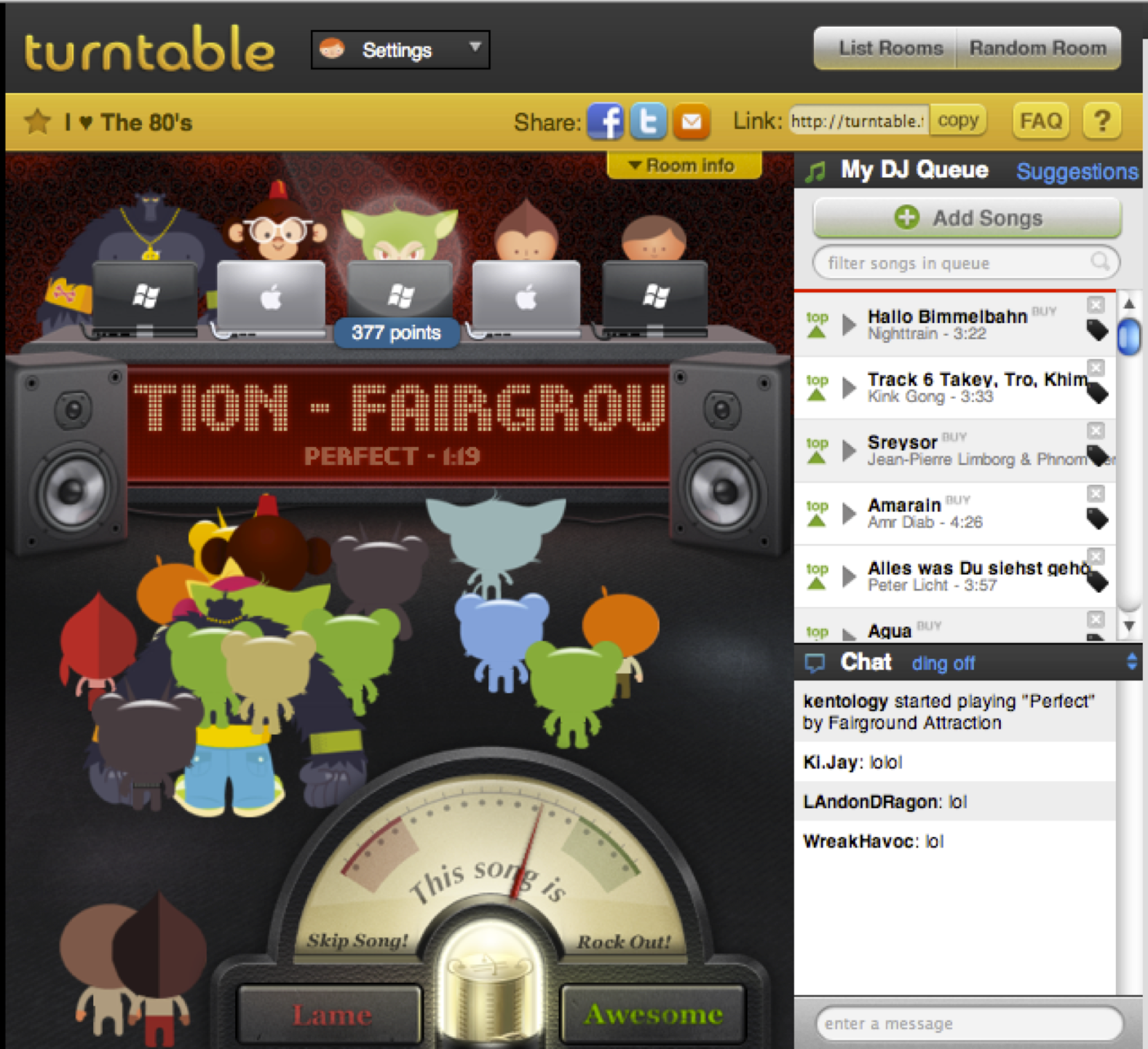 TurnTable.fm With large, and super-sized classes that I teach (575 to 2750 students), part of making the course successful is getting students engaged and connected not just to the material, but to each other and the classroom environment as a whole. Building community in the classroom has been a mission I have increasingly focused on, and getting people connected with each other does not always have to directly involve the course material itself. Towards this effort, we now use a music-playing and sharing platform named TurnTable: a new online social network that revolves around listening to music with others, giving thumbs up to tracks you hear that you like, and earning "DJ points" that win you cool new avatars. For our class, we created a room called 'The International Spin' which is a venue for students to meet each other, introduce each other to international music (which the rest of the class can watch/listen), and form relationships that may end up as friendships, study groups, or just fellow music fans. Check it out at http://turntable.fm/
TurnTable.fm With large, and super-sized classes that I teach (575 to 2750 students), part of making the course successful is getting students engaged and connected not just to the material, but to each other and the classroom environment as a whole. Building community in the classroom has been a mission I have increasingly focused on, and getting people connected with each other does not always have to directly involve the course material itself. Towards this effort, we now use a music-playing and sharing platform named TurnTable: a new online social network that revolves around listening to music with others, giving thumbs up to tracks you hear that you like, and earning "DJ points" that win you cool new avatars. For our class, we created a room called 'The International Spin' which is a venue for students to meet each other, introduce each other to international music (which the rest of the class can watch/listen), and form relationships that may end up as friendships, study groups, or just fellow music fans. Check it out at http://turntable.fm/
Social-Networked Events
We hear a lot about the power of 'social networks' and how everyone in the world is now connected...but how about harnessing the real power of the masses in these networks to produce creative environments and special events? The pedagogy of my courses combines the power of social media/social networking with the motivation and energy of 2700 students to produce a sense of community and amazing outcomes. For instance, the students worked creativity and together through social networks to request and garner visits from notable specialists outside our classroom including:
Request to King Abdullah II of Jordan and recorded response. (response: http://www.youtube.com/watch?v=530r1gMyWAk) (shout out: http://www.youtube.com/watch?v=2a6VMNp5hug)
Live Skype Q+A session with the Prime Minister of Australia, Kevin Rudd. (https://www.youtube.com/watch?v=zLN8lusHeds) (the shout-out: http://www.youtube.com/watch?v=Gra5KJzLh8Q)
Live Skype Q+A session with Nobel Peace Prize recipient and Burmese pro-democracy advocate Aung San Suu Kyi. (http://vimeo.com/33219064) (the shout-out: http://www.youtube.com/watch?v=nGSf_xjFX0o )
Visit from Hollywood legends Martin Sheen and Emilio Estevez who screened their newest international film “The Way” followed by a Q+A (http://goo.gl/wZow8) (the shout-out: http://www.youtube.com/watch?v=uXjNAcJXrBI )
Visit from the founders of ‘Invisible Children,’ an international charity dedicated to rehabilitation of child soldiers in Uganda
Visit from wine guru and social media marketing mogul Gary Vaynerchuk
(story) (the shout out: http://www.youtube.com/watch?v=9axVgDLbROE)
In each of these circumstances, the students and I (and my staff) worked together to craft a message, record the 'shout-out' request with enthusiasm, and then as a collective force made the videos go viral until the connections were made with the targeted celebrity speakers.That the students themselves could bring these highly sought after leaders to the classroom so quickly was empowering and inspiring to all.
The Flipped Syllabus
With increasing enrollments of students from a diverse range of majors, academic levels, and personal backgrounds, my courses have become staples of the undergraduate experience at Virginia Tech. In the last decade, the class size has grown from 50 students to over 2750 students, resulting in some of the largest enrollments at the university. This large class size presents a number of physical and pedagogical challenges to those who engaged in and manage this ultra-large class experiment.
A major shift that the World Regions course has undergone is to make the class more pedagogically accessible and engaging to a larger number of students, while simultaneously making it more manageable for the faculty and graduate assistants who teach. This restructuring has been three-pronged: (a) to implement a system that allows for maximum student flexibility of assignments, (b) to create a positive feedback loop to empower students when it comes to assessment, and (c) to incorporate social networking technologies to build community, engagement, and social presence in and out of the classroom. In essence, the challenge has been to transform the course from a rigid, top-down, and highly structured format to a more decentralized, user-defined, and personalized experience for the learners. The goal is to create an individualized and unique experience for each student, despite the fact that they are participating in a class of 2750 students. I call this experience "Flipping the Syllabus," a reference to shifting the paradigm of coursework from the instructor to the student, in both options and ownership.
 The motivations for this change are plentiful, and long overdue. A guiding assumption for this change is that the standard A to F grading scale is de-motivational to learners. That is, from the very first day of class, a student has an A+, and then instructors give the students a series of assignments and tests that serve to take points away from them when they mark items as incorrect. Every type of assessment, such as a paper or an exam, is viewed not as a chance to gain points but rather as an opportunity to lose them. This then creates a negative feedback loop of failure. Students can only lose and even getting a perfect score is mere maintenance.
The motivations for this change are plentiful, and long overdue. A guiding assumption for this change is that the standard A to F grading scale is de-motivational to learners. That is, from the very first day of class, a student has an A+, and then instructors give the students a series of assignments and tests that serve to take points away from them when they mark items as incorrect. Every type of assessment, such as a paper or an exam, is viewed not as a chance to gain points but rather as an opportunity to lose them. This then creates a negative feedback loop of failure. Students can only lose and even getting a perfect score is mere maintenance.
With a large number of students in a class, a one-size-fits-all class structure becomes increasingly difficult, both for student learning and class management logistics. Students in the World Regions class come from diverse backgrounds (with approximately 80 countries represented), with different levels of knowledge and experiences, driven by differing motivations and maturity. As the class size and student diversity increases, it becomes increasingly difficult for instructors to devise a single exam or assignment to challenge and assess such a group. For example, trying to schedule an out-of-class event, such as an exam, for 2750 people becomes an overwhelming and consuming task. The standard operating procedure for a college class simply becomes an exercise in frustration when dealing with this many students at one time.
In re-conceiving the class to be learner centered, community building, and relevant to today’s students, the outcomes for the class were revisited to ensure the course aligned with the course description, modern world geography and current world events, and perceived student prior knowledge and cultural experience. These outcomes were then used to develop a positive and flexible assessment system focusing on point accumulation, rather than point reduction. This new approach required the development of several avenues where students could demonstrate their knowledge and performance, while accumulating points. At the end of the semester, the students' points are tallied, based upon the works completed, and a final grade assigned based upon a predetermined, criterion-referenced scale.
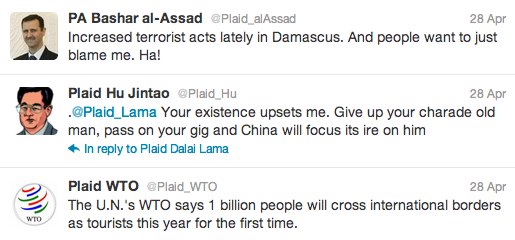 The options for graded assignments include traditional avenues (i.e., weekly quizzes, atlas-based quizzes, midterm/final exams, and current events papers), social media avenues (i.e., World Leader Shadow twitter assignment, international news online commenting conversations, “flash” podcast quizzes, international film reviews), and sociocultural avenues (e.g., out-of-class international events attendance, travel correspondence and reporting). This method allows the students to choose assignments that interest them personally, that takes advantage of natural abilities, express individual creativity, and demonstrate world geography knowledge and skill. An abundance of options is offered, so that the actual point possibilities far exceed what is necessary to earn and “A”; thus, there is plenty of flexibility in the system in terms of choice. Indeed, no single assignment is required, not even exams. If the student plans well, works hard, and turns in quality work, that student can choose to forego all the traditional assessment options. The harder a student works, the more points that student can then earn. The result is a true meritocracy.
The options for graded assignments include traditional avenues (i.e., weekly quizzes, atlas-based quizzes, midterm/final exams, and current events papers), social media avenues (i.e., World Leader Shadow twitter assignment, international news online commenting conversations, “flash” podcast quizzes, international film reviews), and sociocultural avenues (e.g., out-of-class international events attendance, travel correspondence and reporting). This method allows the students to choose assignments that interest them personally, that takes advantage of natural abilities, express individual creativity, and demonstrate world geography knowledge and skill. An abundance of options is offered, so that the actual point possibilities far exceed what is necessary to earn and “A”; thus, there is plenty of flexibility in the system in terms of choice. Indeed, no single assignment is required, not even exams. If the student plans well, works hard, and turns in quality work, that student can choose to forego all the traditional assessment options. The harder a student works, the more points that student can then earn. The result is a true meritocracy.
This flexible approach also resolves most logistical issues: nothing is required, so there are no exam make-ups, no excuses to process, no deadline extensions, no extra credit, and no need for a grading curve. If a student misses an assignment, that students may simply choose another assignment option to earn points in a different way. For example, if a student must miss an exam, that student may earn the missing exam points by completing an additional assignment such as a paper or film reviews. Most importantly, at the end of the semester, there is little justification for grading complaints. With so many options offered throughout the semester, students inherently understand that earning a certain grade is about individual responsibility and self-regulation. Just as important, this is a system of counting up to the grade that a student earns, instead of counting down from the perfect grade assumed at the beginning of a traditionally graded course. This method is intended to motivate students with challenge, choice, control, and curiosity instead of presenting them hurdles to be overcome. Isn't that what education is really supposed to be all about?
View my 2012 World Regions class syllbus (pdf)
Technologies Used in Assignments
But this blog page is supposed to be focusing on technologies used in the classroom, so let's get back to that now. Creating so many more new and diverse assignments in the 'Flipped Syllabus' model has allowed for further integration of readily accessible on-line technologies, forum and blog creations, as well as utilizing social networking tools for experimental 'educational' assignments. Of course, these new forays into full-on digital exercises are buttressed by more traditional assessment options like on-line weekly quizzes on textbook readings, midterm and final exams, and even written film and international event reviews--but even these options are created, delivered and executed entirely on-line. Below are brief introductions to the more creative and experimental technologies adopted and adapted for our World Regions class assignments:
 Delicious (social bookmarking)
Delicious (social bookmarking)
Even though we live in an era of unprecedented technological innovation, there’s more junk, noise and crap on the internet than ever, and with more people online than ever, the problem gets worse every day. Over the course of the semester, our Delicious assignment attempts make sense of some of the noise on the web by creating a collection of news sources from around the world that are vetted by students for credibility and reliability. Students can create one a week, containing no less than 5 tags and individual assessments on each article, and the overall theme of their page. But what is Delicious?
Delicious is a web-based social bookmarking site through which links from anywhere on the internet can be saved, shared and accessed from any computer at any time. Links can be organized through tags, or organizational keywords, and they can be curated into “stacks”: playlists of five or more links that have been created around a central topic or theme. Tags are incredibly important to the Plaid News Product as they make it possible to easily navigate and discover new content on the web, and make it easy to create a space that has a variety of views represented about a single news topic. When viewing a student's 'stack' we can see they have researched the topic by providing analysis on multiple links, from multiple news sources, on the subject of their choice.
Plaid Avenger Forums One of our main assignments takes advantage of the proliferation of online news sources and encourages active engagement, interaction, and research with the current events that are unfolding during the course of the semester. To demonstrate relevant knowledge and earn points, students may post comments digitally to international stories on credible, vetted news sites like The Economist, BCC, Al Jazeera, or Asia Times On-line . Specifically, students are required to read the story, analyze the content, and then make a thoughtful contribution to the ongoing “reader’s comments” discussion of the news story. This assignment provides students with the opportunity and motivation to engage in authentic discourse with contributors across the globe.
The popularity of this assignment has led to development of online forums specifically for the World Regions class website at http://www.plaidavenger.com/forum On th.is class website students post news stories from any news source, summarize the content of the story, and then comment on the story, while also interacting with other students' submitted news stories. This promotes not only reading, research, and content engagement, but also digital literacy and digital civility...the art of respectfully conversing with fellow humans on-line, which is an increasingly 'lost art' that needs to be re-instilled in the current generation of students.
 Twitter assignment One of the first entirely social media assignments created for class is the "Twitter World Leader Shadow Cabinet". For this assignment, a student adopts the persona of a president or prime minister and reports on the leader’s location, actions, and thoughts--in the first person, as that person, on Twitter. The student is responsible for searching for news stories related to the world leader specifically focusing on the “where” and “what” of that leader’s current role on the world scene. Students are encouraged to interact with the other leaders on Twitter, while maintaining the character of the real leader they represent; if the real US President Obama meets with the real Mexican President Felipe Calderon, then our 'plaid leaders' representing them also have to interact with each other, and discuss the topics the real people discussed.
Twitter assignment One of the first entirely social media assignments created for class is the "Twitter World Leader Shadow Cabinet". For this assignment, a student adopts the persona of a president or prime minister and reports on the leader’s location, actions, and thoughts--in the first person, as that person, on Twitter. The student is responsible for searching for news stories related to the world leader specifically focusing on the “where” and “what” of that leader’s current role on the world scene. Students are encouraged to interact with the other leaders on Twitter, while maintaining the character of the real leader they represent; if the real US President Obama meets with the real Mexican President Felipe Calderon, then our 'plaid leaders' representing them also have to interact with each other, and discuss the topics the real people discussed.
In pursuit of student understanding of world leader responsibilities, the Leader Shadowing activity requires participating students to adopt a world leader and to “tweet,” several times daily, regarding that leader’s activities, actions, and motivations (see http://twitter.com/plaidavenger/world-leaders). This use of Twitter provides a pedagogically sound avenue for students to engage with the responsibilities of their world leader while simultaneously commenting on the actions and motivations of other leaders – using technology to foster critical thinking and social interaction.
“Flash” quizzes Based on current events podcasts from the Professor as well as some expanded podcasts from the Plaid Avenger himself, students can elect to participate in flash quizzes. These are completely online, socially networked versions of a traditional unannounced 'op' quiz. For these flash quizzes, students have three hours to take the quiz and are informed about it only through social media. Because of this, staying connected with the class community is the only way to discover these point opportunities. This class activity has been embraced as a gaming device of particular intrigue to this current generation of college students, as have all of the aforementioned uses of technology in the class.
The typical evolution of a flash quiz is as follows: 1)Based upon student interest and questioning during the live lecture, the professor selects a current event theme to expand upon more fully on-line. 2)The professor creates a 15 to 25 minute 'mini-lecture' podcast integrating news sources while underscoring and reinforcing themes discussed in the lecture. 3)We create a question pool and on-line quiz that will be activated 2 to 3 different times throughout the next day, and it is accessible for a window of an hour each time. 4)The podcast and quiz times info is sent out 8 to 12 hours in advance, in email and social networking platforms. 5)Once a student starts the quiz, they only have 5 minutes to complete it.
Flash quizzes get one attempt only, with questions randomly pulled from a larger question pool, and a minimum score must be achieved in order for the attempt to count towards points at all. Thus the student is encouraged to actually review the material in advance, as random guessing at answers will likely not yield a high enough score to count, and simply trying to 'google' the answers as you go becomes too challenging within the 5 minute time constraint. It just pays to watch the video and learn! Thus, new lecture/book themes are reinforced, new current event material integrated in, and along with the quizzes, this hopefully establish long-term memory and critical thinking of course material. Student response has been exceptionally positive to this experiment, for reasons that elude me.
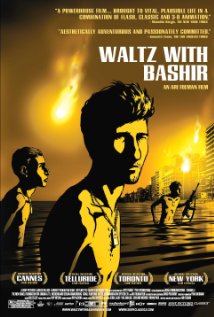 International Cinema While not technically a new-wave technological innovation, I also heavily incorporate film into my courses, and am working on a revolutionary new way to view/debate/learn from cinema in an on-line format as well. First, the basics:
International Cinema While not technically a new-wave technological innovation, I also heavily incorporate film into my courses, and am working on a revolutionary new way to view/debate/learn from cinema in an on-line format as well. First, the basics:
My 'International Movie Nights' have become a staple of my course, and the general university campus as well, as current students, former students, and friends/family of students often come in to our classroom to share the film experiences and talks we have on a weekly basis. The International Movie Nights occur 12 times during the semester, (students can attend as many as they like for credit) and focuses on movies--e.g. Udon, Paradise Now, Sin Nombre, and City of God--from different regions of the world that examine an issue or issues whose influence on contemporary life extends beyond the boundaries of the U.S. and significantly involves other societies, cultures, and geographical locations. In addition, each movie night begins with the instructor contextualizing the world region, the film, and why the film is important in developing an understanding of the world and world events. The International Movie Nights emphasize an inclusive pedagogy aimed at educating all students and introducing them to different landscapes, cultures, histories, music, languages, and attitudes via the widely embraced medium of movies.
The future of this assignment will be to evolve out a model and method to conduct the movie viewing experience and film discussion in an entirely on-line environment, thus students could watch the film from wherever they want and still be included in an on-line conversation before/after the film. This would also allow us to expand the experience to distance learners, and also connect up multiple classrooms interested in the film/subject from around the country, or the world. While I still personally think film is best viewed communally in a big dark room with a big screen, I hope that possibly this experiment will yield a new way to experience film with peers while maintaining that sense of community and shared experience, albeit in a totally digital environment.
If you would like to see how we describe and explain and assess these assignments from a student perspective, please feel free to download and use my course syllabus any way you like. And feedback is heartily encouraged, of course!
Sharing Our Educational Experiences with the World
South by Southwest Interactive Conference (SxSW), Austin TX, March 10, 2013
Title: Going Graphic with the News http://schedule.sxsw.com/2013/events/event_IAP4472
South by Southwest Education Conference (SxSW.edu), Austin TX, March 5, 2013
Topic: How Video Calls Globalize Shared Learning http://schedule.sxswedu.com/events/event_EDUP7265
Speaker at University of Texas at Arlington, March 4, 2012
Topic: Building Community in Online, Blended, and Face-to-Face Environments & Incorporating Social Media into the Classroom
Speaker at TEDxBinghamtonUniversity, February 24, 2013
Topic: Homo habilis U - Reinventing the University Experience (http://www.youtube.com/watch?v=pSzXv6NScRw)
Speaker at Binghamton University, February 22, 2013
Topic: Building Community in Online, Blended, and Face-to-Face Environments- A fantastic way to enrich the classroom experience….but what, why, who, and how?
Speaker at TEDxVirginiaTech, November 10, 2012
Topic: More Passion, Less Pedagogy (http://www.youtube.com/watch?v=QyT2yqtuqS4)
Digital keynote speaker at Griffith University, Blended Learning Symposium, October 28, 2012
Topic: Tools and Ideas for Blended Learning
Keynote speaker at Curtin University in Perth, Australia, Teaching and Learning Symposium, October 18, 2012.
Topic: Flipping the Syllabus
Keynote speaker at the 2012 Texas Higher Education Leadership Conference in Austin, TX. October 4, 2012.
Topic: Expanding Engagement to Thousands: Strategies for Expanded Classrooms
Southern Polytechnic and State University in Marietta, GA. September 2012
Topics: Flipping the Syllabus
Bringing the World to Your Classroom and Your Classroom to the World
Connecting to the Real World: Why Engineers Need to be International in Outlook
Keynote speaker SIM University in Singapore, July 2012, Faculty Learning Day
Topic: Building Community in Online, Blended, and Face-to-Face Environments
Speaker at SIM University in Singapore, July 2012, Faculty Learning Day workshops
Topics: Integrating Specialists into Teaching
Bringing the World to Your Classroom, and Your Classroom to the World
Flipping the Syllabus
Digital Communication Tools
South by Southwest Interactive Conference (SxSW), March 2012, Austin TX Title: Supersizing the Classroom: 3000 Students & Beyond
http://schedule.sxsw.com/2012/events/event_IAP10043 (podcast of talk)
http://www.ustream.tv/recorded/21104087 Associated Press interview at SxSW, 03/14/12
South by Southwest Education Conference (SxSW.edu), March 2012, Austin, TX Title: Supersizing the Classroom: 3000 Students & Beyond
http://schedule.sxswedu.com/event/sxsw/sxswedu_embed/events/view/14030/
http://audio.sxsw.com/2012/podcasts/edu/06_Supersizing_the_Classroom_3000_Students.mp3 (podcast of talk)
Association of American Geographers (AAG) Annual Meeting in New York, NY Feb. 2012 Title: Expanding Geographic Horizons: Tools and Tips for Large Geography Classrooms
Conference on Higher Education Pedagogy (CHEP), Feb. 2012, Blacksburg, VA. Title: Expanding Engagement to Thousands: Communication Tools for Large Classes
International Society for Exploring Teaching and Learning (ISETL), 10/14/11 San Diego, CA. Boyer, J., Doolittle, P., Byrd, C.N., & Pritchard, K. Title: Teaching in Large and Ultra-Large Classes